Maintain your roof's peak condition this spring. Inspect shingles for cracks or damage. Clean gutters and downspouts to avoid pooling water. Check for leaks and signs of water damage. Trim overhanging branches to protect your roof. Maintain proper attic ventilation to prevent moisture buildup. Inspect flashing and seals for any issues. Look out for pest infestation and address it promptly. This checklist will keep your roof sturdy and secure.
Inspect Roof Shingles
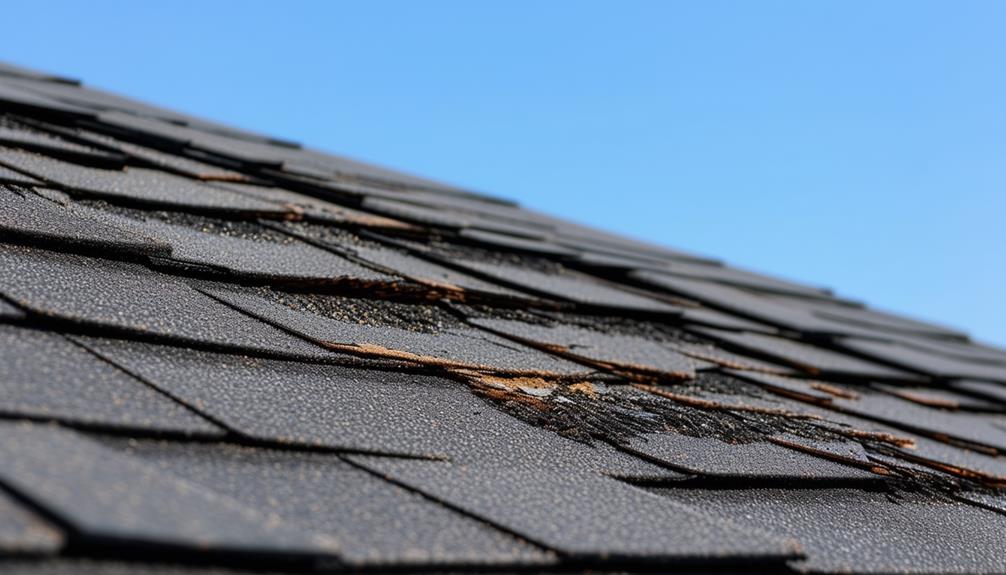
Inspect your roof shingles carefully for any signs of damage, wear, or loose pieces that may indicate potential issues. Shingle maintenance is vital for ensuring the longevity and protection of your roof. Look out for cracked, curled, or missing shingles, as they can lead to leaks and water damage. Pay close attention to the areas around chimneys, vents, and skylights, as these are common trouble spots. If you notice any issues, it's best to address them promptly to prevent further damage.
Regularly inspecting your roof shingles is a proactive way to maintain your roof's integrity and enhance its overall protection. By identifying and fixing problems early on, you can avoid costly repairs down the line. Additionally, keeping your shingles in good condition contributes to the overall aesthetic appeal of your home. Remember, a well-maintained roof not only safeguards your property but also adds value to it. Prioritize shingle maintenance as part of your routine roof care to ensure a sturdy and secure roof over your head.
Clean Gutters and Downspouts
Now it's time to verify that your gutters and downspouts are in top shape for the season. Begin by clearing any debris from the gutters to prevent blockages. Check for clogs and make sure that water can flow freely to prevent potential water damage to your roof and home.
Clear Debris From Gutters
Make sure to thoroughly clean out your gutters and downspouts to prevent any blockages and guarantee proper drainage for your roof. Gutter maintenance is essential for the overall health of your roof. Start by removing any debris such as leaves, twigs, and dirt that may have accumulated over the winter months. This debris removal will allow rainwater to flow freely through the gutters and downspouts, preventing water from pooling on your roof.
To clean your gutters effectively, use a sturdy ladder and wear gloves to protect your hands. Scoop out the debris by hand or use a small shovel to carefully remove it. Once the visible debris is cleared, use a garden hose to flush out any remaining dirt and ensure that water can flow smoothly through the gutters and downspouts.
Regular gutter maintenance, including debris removal, can help prevent water damage to your roof, siding, and foundation. By taking the time to clear debris from your gutters, you are investing in the longevity and effectiveness of your roof drainage system.
Check for Clogs
Thoroughly examine your gutters and downspouts to identify and clear any clogs that may impede proper drainage from your roof. Gutter maintenance is essential to prevent water damage and maintain the integrity of your roof. Start by visually inspecting your gutters for any visible debris such as leaves, twigs, or dirt. Use gloves and a scoop to remove this debris, ensuring that the gutters are free-flowing. Next, check for any clogs by running water through the gutters and observing if it drains properly. If you notice any drainage issues, use a plumber's snake or pressure washer to dislodge the clog.
Downspouts are also prone to clogging, so make sure to inspect and clean them as well. Use a garden hose to flush out any debris stuck in the downspouts, ensuring that water can flow freely away from your roof. Regular gutter maintenance will help prevent water damage and prolong the lifespan of your roof.
Ensure Proper Drainage
Inspect your gutters and downspouts meticulously to guarantee proper drainage by removing any clogs that could hinder water flow from your roof. Start by clearing out debris such as leaves, twigs, and dirt from the gutters. Use a sturdy ladder and gloves for safety. After clearing the gutters, check the downspouts for any blockages. You can use a plumber's snake or a garden hose to dislodge debris stuck in the downspouts. Consider installing gutter guards to prevent future clogs and reduce the frequency of cleaning.
In addition to cleaning, make sure that your downspouts have extensions to direct water at least 5-10 feet away from your home's foundation, preventing water damage. Check the grading around your home to ensure water flows away from the structure. Proper landscaping can also aid in water drainage by creating sloped areas away from the house. By maintaining clean gutters, downspouts, and incorporating these drainage practices, you can protect your roof and foundation from potential water-related issues.
Check for Leaks and Water Damage
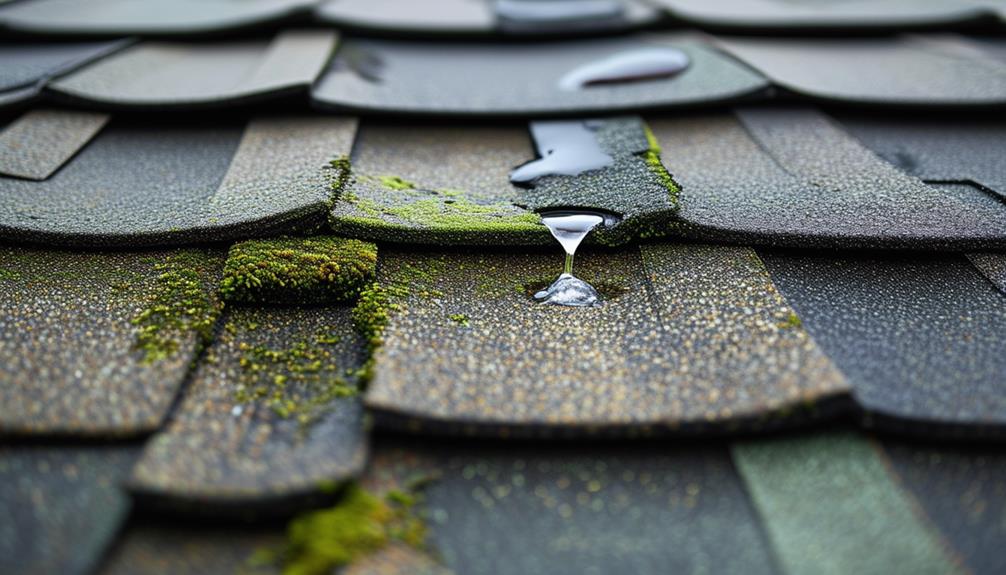
Inspect your roof carefully for any signs of leaks or water damage, such as discolored areas, sagging spots, or dampness. Regular roof maintenance tips can help prevent extensive water damage. Start by examining the shingles for any cracks, missing pieces, or areas where they may have lifted. Check the flashing around chimneys, vents, and skylights to make sure they are properly sealed and free of damage. These areas are common entry points for water and should be maintained regularly.
Water damage prevention is key to maintaining the integrity of your roof. After heavy rainfall or snow, make sure to check your attic or ceiling for any signs of water infiltration. Addressing leaks promptly can prevent them from escalating into more significant issues. Additionally, keeping your gutters clean and free of debris is essential for proper water drainage. Clogged gutters can lead to water backing up under the roofline, causing potential leaks and water damage. Regularly inspecting your roof for leaks and water damage can help you catch issues early and avoid costly repairs down the line.
Trim Overhanging Branches
Consider trimming overhanging branches near your roof to prevent potential damage and maintain the safety of your home. Tree maintenance plays a vital role in protecting your roof from various risks. Overhanging branches can scrape against the roof, causing shingle damage, and in severe cases, even puncture the roof's surface. By regularly trimming these branches, you reduce the chances of debris accumulating on the roof and clogging gutters, which can lead to water damage.
When undertaking tree maintenance, it is important to take safety precautions seriously. Make sure that you have the proper tools for the job, such as sturdy ladders and pruning shears. If the branches are too high or difficult to reach, consider hiring a professional tree service. Always wear appropriate safety gear, including gloves, goggles, and a hard hat. Before trimming, inspect the branches for signs of disease or weakness that could make them hazardous to work on. By following these safety precautions, you can effectively maintain your roof's integrity while safeguarding your well-being.
Ensure Proper Attic Ventilation
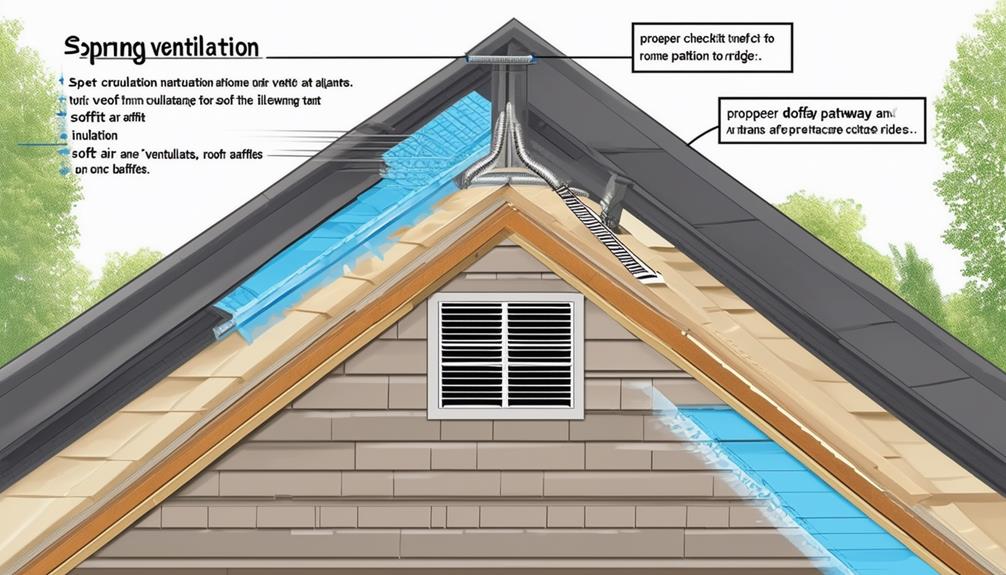
To maintain your roof's health and longevity, proper attic ventilation is essential for regulating temperature and moisture levels. Attic insulation plays a vital role in this process, helping to keep your home comfortable and energy-efficient. Adequate ventilation allows for the circulation of air, preventing heat buildup in the summer and moisture accumulation in the winter, which can lead to mold and mildew growth.
Moisture control is imperative to prevent damage to your roof structure and insulation. Without proper ventilation, excess moisture can get trapped in the attic, causing wood rot and compromising the integrity of your roof. By ensuring that your attic is well-ventilated, you can mitigate the risk of costly repairs and prolong the lifespan of your roof.
Regularly inspect your attic to confirm that insulation is properly installed and that vents are clear of obstructions. If you notice any signs of inadequate ventilation or moisture issues, consider consulting a professional to address these concerns promptly. Prioritizing proper attic ventilation is a proactive measure that safeguards your roof and home from potential damage.
Remove Debris From Roof
When maintaining your roof this spring, start by clearing your gutters of debris to prevent water buildup. Inspect your roof for any signs of damage, such as loose shingles or cracks. Additionally, trim any overhanging branches that could potentially damage your roof during storms.
Clear Gutter of Debris
Make sure your gutters are free of any debris by conducting a thorough inspection and promptly removing any build-up on the roof. Gutter maintenance is essential in preventing water damage and is an integral part of seasonal cleaning and overall roof care strategies. Clogged gutters can lead to water overflow, causing damage to your roof, siding, and foundation. To clear debris effectively, start by using a sturdy ladder, gloves, and a scoop or trowel to remove leaves, twigs, and dirt from the gutters. It's important to check for any blockages in the downspouts and make sure that water can flow freely. After clearing the gutters, flush them with water using a hose to remove any remaining debris and check for proper drainage.
Regular gutter maintenance will help extend the lifespan of your roof and prevent costly water damage repairs in the future. By incorporating this simple task into your spring roof maintenance routine, you can ensure that your gutters function efficiently and protect your home from potential water-related issues.
Inspect for Damage
Inspect your roof for any debris accumulation that may cause damage and hinder its functionality. Debris like branches, leaves, or trash can trap moisture, leading to rot and mold growth. Start by visually scanning the roof's surface for any visible debris. Use a ladder to get a closer look if needed, but always prioritize safety.
Evaluating hail damage is vital after the winter months. Look for dents or dimples on metal surfaces, missing granules on asphalt shingles, or cracks on tiles. Hail damage may not always be immediately apparent, so a professional inspection might be necessary.
Another important aspect of roof maintenance is repairing roof leaks promptly. Inspect the interior of your home for water stains or mold growth, as these could indicate a leak. Trace the source of the leak back to the roof and address it immediately to prevent further damage to your property.
Regularly checking for and removing debris, evaluating hail damage, and promptly repairing roof leaks are essential steps in maintaining a healthy and functional roof. Additionally, trimming overhanging branches and cleaning out gutters can prevent unnecessary strain on the roof and reduce the risk of water damage. Incorporating fall roof maintenance tips, such as inspecting flashing and seals before the colder months arrive, can help identify potential problem areas early. Taking these preventive measures ensures the longevity of your roof and protects your home from costly repairs.
Trim Overhanging Branches
To maintain a well-kept roof, make sure to trim overhanging branches that may be depositing debris onto your roof's surface, potentially causing damage over time. Tree maintenance plays an important role in the longevity of your roof. Overhanging branches not only drop leaves and twigs onto your roof but also provide easy access for pests looking to nest in the debris. This debris can trap moisture, leading to rot or mold growth, which can compromise your roof's integrity.
Regular landscape care, including trimming overhanging branches, is essential in preventing costly repairs. It is recommended to trim branches that are within a 10-foot radius of your roof. By doing so, you reduce the risk of debris accumulation and minimize the chances of critters finding their way onto your roof. Additionally, keeping branches trimmed away from your roof can help promote better air circulation, which can aid in preventing moss and algae growth.
Prioritize tree maintenance as part of your spring roof maintenance checklist to ensure a healthy roof for years to come.
Inspect Flashing and Seals
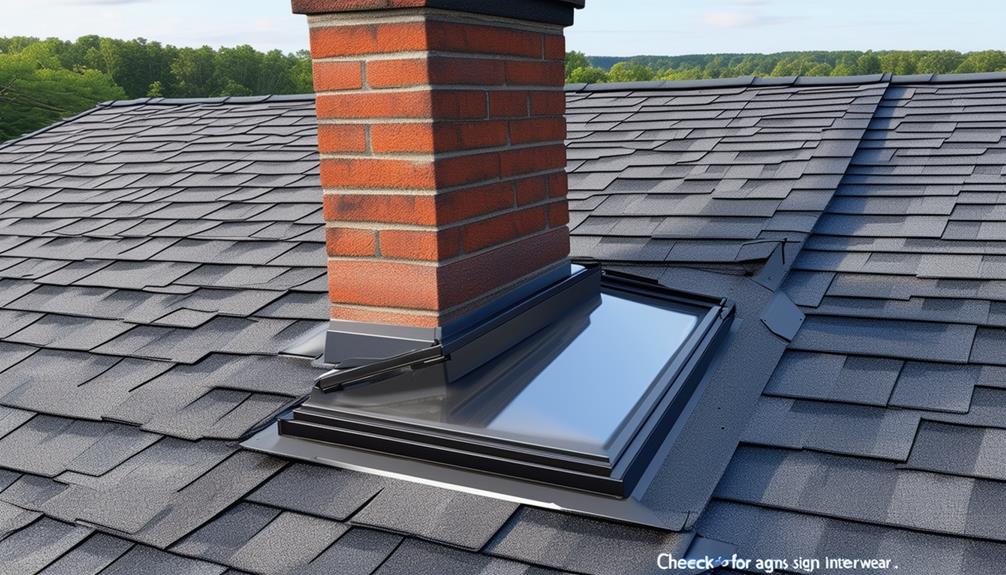
Make sure that all flashing and seals on your roof are thoroughly examined for any signs of wear or damage. Neglecting these essential components could lead to water leaks and further costly repairs down the line. Here are some key steps to follow:
- Seal Inspection: Begin by checking the seals around vents, chimneys, skylights, and any other protrusions on your roof. Look for cracks, gaps, or areas where the sealant has deteriorated. If you notice any issues, promptly reseal these areas using a compatible roofing sealant.
- Flashing Repair: Inspect the flashing around your roof's edges, valleys, and intersections for signs of rust, corrosion, or damage. If the flashing is damaged, consider using DIY repair options like applying a new layer of roof sealant or installing replacement flashing to ensure proper protection against water infiltration.
- Regular Maintenance: Make it a habit to inspect the flashing and seals on your roof at least twice a year, ideally in the spring and fall. This routine check can help catch any issues early on and prevent more significant problems in the future.
Look for Signs of Pests
Scan your roof and surrounding areas for any indications of pest infestation, as early detection can help prevent potential damage to your property. Look for signs such as chewed or damaged roofing materials, droppings, nests, or even sightings of pests themselves. Rodents, insects, and birds can cause harm to your roof and home if left unchecked. To guarantee your property remains pest-free, consider implementing pest control measures as part of your spring roof maintenance routine. Prevention is key, so seal any entry points on your roof where pests could gain access. Regular pest inspection and treatment can help you identify and address any infestations promptly. If you notice any signs of pests during your roof maintenance checks, contact a professional pest control service to assess the situation and recommend appropriate treatment. By staying vigilant and taking proactive steps, you can protect your roof from potential pest damage.
Schedule Professional Roof Inspection
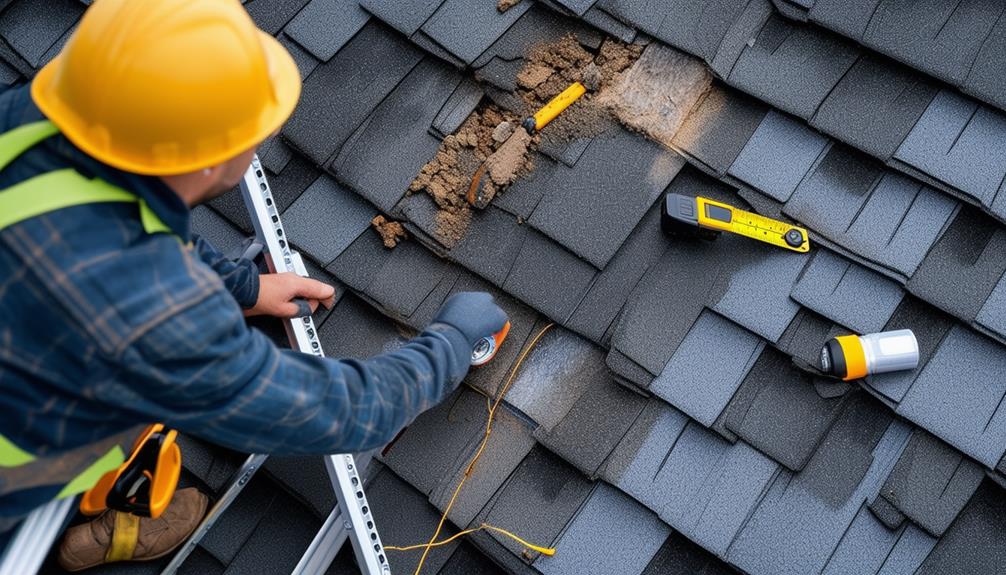
Consider hiring a qualified roofing professional to conduct a thorough inspection of your roof to confirm its structural integrity and identify any potential issues. While DIY roof maintenance is possible, professional inspections offer a level of expertise and attention to detail that can be essential in catching problems early. Here are three reasons why scheduling a professional roof inspection is important for the longevity of your roof:
- Expertise: Roofing professionals have the training and experience to detect even minor issues that an untrained eye might miss. Their knowledge can help address problems before they escalate.
- Safety: Climbing onto a roof can be dangerous, especially without the proper equipment and knowledge. Professionals are equipped to handle inspections safely, reducing the risk of accidents.
- Thorough Evaluation: Professional inspections provide a thorough evaluation of your roof, including areas that may not be easily visible from the ground. This detailed assessment can reveal hidden issues that could lead to costly repairs if left unattended. Regular inspections are essential for proactive roof maintenance and ensuring the longevity of your home's protective covering.
Frequently Asked Questions
How Can I Prevent Moss Growth on My Roof Shingles?
To prevent moss growth on your roof shingles, try using certain roof cleaning methods like scrubbing with a mixture of water and bleach. Moss prevention techniques such as trimming overhanging tree branches can also help. Regularly cleaning debris from your roof and ensuring proper ventilation can deter moss growth. By following these steps, you can maintain a moss-free roof and prolong its lifespan.
Are Gutter Guards Necessary to Prevent Clogging?
Gutter guards can be essential in preventing clogs and maintaining your roof shingles. They are highly effective in keeping debris out of your gutters, allowing water to flow freely. By installing gutter guards, you can greatly reduce the risk of clogs that can lead to water damage and affect the longevity of your roof. Regular maintenance, combined with gutter guards, is a proactive approach to safeguarding your roof's health.
What Are Common Causes of Attic Condensation?
Attic condensation can cause mold and mildew if left unchecked. Maintain proper insulation and ventilation to prevent moisture buildup in your attic. Remember, roof leaks can also contribute to condensation issues. By addressing these factors, you can uphold a healthy attic environment and protect your home from potential damage. Regularly inspecting your roof and attic for any signs of leaks or inadequate ventilation is vital for preventing condensation problems.
Can Tree Roots Damage My Roof Structure?
Yes, tree roots can damage your roof structure. As trees grow, their roots can spread wide and deep, potentially causing soil erosion and compromising your roof's foundation. In addition to this, tree roots can create drainage issues by blocking gutters and downspouts, leading to water infiltration and damage to your roof. Regularly inspecting and trimming trees near your home can help prevent these issues and protect your roof.
How Often Should I Reseal Roof Flashing?
Regularly resealing roof flashing is essential for maintaining a watertight seal and preventing leaks. To keep your roof in top shape, creating a consistent roof maintenance schedule that includes flashing inspection is key. Depending on your climate and roof condition, aim to reseal flashing every 2-5 years. By staying proactive with this maintenance task, you can extend the lifespan of your roof and avoid costly repairs down the road.
Conclusion
Now that you've completed your spring roof maintenance checklist, your roof is in tip-top shape and ready to withstand any weather Mother Nature throws its way! By following these simple steps, you've guaranteed the longevity and durability of your roof for years to come. So sit back, relax, and enjoy the peace of mind that comes with a well-maintained roof – you're practically invincible against the elements now!




